CHAPTER VIII.
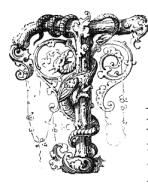
HE first village below Albany is the pretty one of
Castleton, on the Hudson River Railway, about eight miles below Greenbush.
Around it is a pleasant agricultural country, and between it and Albany, on
the western shore, flows in the romantic Norman's-Kill (the Indian Tawasentha,
or Place of many Dead), that comes down from the region of the lofty Helderbergs.
Upon the island in the Hudson, at the mouth of this stream--a noted place
of encampment and trade for the Iroquois--the Dutch built their first fort
on the Hudson in 1614, and placed it in command of Captain Christians. The
island was named Kasteel, or Castle, and from it the little village just mentioned
received its name. The alluvial "flats" in this neighbourhood are
wide, and low islands, partly wooded and partly cultivated, divide the river
in channels. They stretch parallel with the shores, a considerable distance,
and the immense passenger steamers sometimes find it difficult to traverse
the sinuous main channel. These, and the tall--masted sloops, have the appearance,
from the Castleton shore, of passing through vast meadows, the water that
bears them not being visible.
In this vicinity is the famous hidden sand--bar, called Overslagh by the Dutch, so formidable to the navigators of this part of the river, not because of any actual danger, but of tedious detentions caused by running aground. Some improvements have been made. In former years the sight of from twenty to fifty sail of river craft, fast aground on the Overslagh at low tide, was not rare, and the amount of profanity uttered by the vexed sailors was sufficient to demoralize the whole district. This bar is formed by the sand brought in by the Norman's Kill and other streams, and large sums have been expended in damming, dredging, and dyking, without entire success. As early as 1790, the State legislature authorized the proprietors of Mills and Papskni Islands to erect a dam or dyke between them, so as to throw all the water into the main channel, and thus increase its velocity sufficient to carry away the accumulating sand. It abutted, but did not cure the difficulty. This bar is a perpetual contradiction to the frequent boast, that the navigation of the Hudson is unobstructed along its entire tide--watercourse. The Overslagh is the only exception, however.
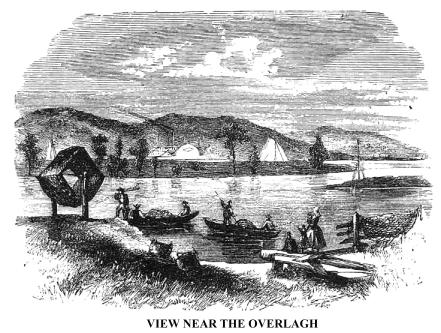 About
four miles below Castleton, is the village of Schodack, a derivative from
the Mohegan word is--cho--da, "a meadow, or fire--plain."
This was anciently the seat of the council fire of the Mohegans upon the Hudson.
They extended their villages along the eastern bank of the stream, as high
as Lansingburgh, and their hunting grounds occupied the entire counties of
Columbia and Rensselaer. As the white settlements crowded there, the Mohegans
retired eastwardly to the valley of the Housatonnuc, in Massachusetts, where
their descendants, known as the Stockbridge Indians, were for a long time
religiously instructed by the eminent Jonathan Edwards. They embraced Christianity,
abandoned the chase as a means of procuring subsistence, and adopted the arts
of civilized life. A small remnant of these once powerful Mohegans is now
living, as thriving agriculturists, on the shores of Winnebago Lake, in the
far north-west.
About
four miles below Castleton, is the village of Schodack, a derivative from
the Mohegan word is--cho--da, "a meadow, or fire--plain."
This was anciently the seat of the council fire of the Mohegans upon the Hudson.
They extended their villages along the eastern bank of the stream, as high
as Lansingburgh, and their hunting grounds occupied the entire counties of
Columbia and Rensselaer. As the white settlements crowded there, the Mohegans
retired eastwardly to the valley of the Housatonnuc, in Massachusetts, where
their descendants, known as the Stockbridge Indians, were for a long time
religiously instructed by the eminent Jonathan Edwards. They embraced Christianity,
abandoned the chase as a means of procuring subsistence, and adopted the arts
of civilized life. A small remnant of these once powerful Mohegans is now
living, as thriving agriculturists, on the shores of Winnebago Lake, in the
far north-west.
About seven miles below Schodack is Stuyvesant Landing, the "port" of Kinderhook (Kinders Hoeck), the Dutch name for "children's point, or corner." It is derived, as tradition asserts, from the fact that a Swede, the first settler at the point at Upper Kinderhook Landing, had a numerous progeny. The village, which was settled by Dutch and Swedes at an early period, is upon a plain five miles from the river, with most attractive rural surroundings. There, for more than twenty years after his retirement from public life, the late Honourable Martin Van Buren, a descendant of one of the early settlers, and the eighth president of the United States, resided. His pleasant seat, embowered in lindens, is called "Lindenwold," and there, in delightful quietude, the retired chief magistrate of the republic spent the evening of his days.
The country road from Kinderhook to the Coxsakie station passes through a rich and well-cultivated region, and leads the tourist to points from which the first extensive views of the magnificent range of the Katzbergs may be obtained.
Coxsakie village is upon the west side of the river, partly along the shore for a mile, in three clusters. The more ancient portion, called Coxsakie Street, is upon a beautiful plain a mile from the river. The latter was originally built upon the post road, as most of the old villages along the Hudson were, the river traffic being at that time inconsiderable. The name is the Iroquois word Kuxakee, or the Cut Banks, Anglicised. Its appropriateness may be understood by the form of the shore, whose banks have evidently been cut down by the rushing river currents that sweep swiftly along between an island and the main, when the spring freshets occur. From a high rocky bluff at the ferry, on the east side of the river, a fine view of Coxsakie, with the blue Katzbergs as a background, may be obtained. Turning southward, the eye takes in a broad expanse of the river and country, with the city of Hudson in the distance, and northward are seen the little villages of Coeymans and New Baltimore, on the western shore. The site of the former bore the Indian name of Sanago. It was settled by the Dutch, and received its present name from one of its earlier inhabitants.
It was in blossoming May, in 1860, when the shad fishers were
in their glory, drawing full nets of treasure 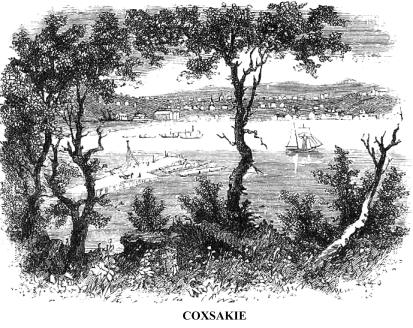 from
the river in quick succession, when the "tide served," that I visited
this portion of the Hudson. On both sides of the river they were pursuing
their vocation with assiduity, for "the season" lasts only about
two months. The immense reels on which they stretch and dry their nets, the
rough, uncouth costume of the fishermen, appropriate to the water and the
slime, the groups of young people who gather upon the beach to see the "catch,"
form interesting and sometimes picturesque foregrounds to every view on these
shores. The shad* is the most important fish of the Hudson, being very delicious
as food, and caught in such immense numbers, as to make them cheap dishes
for the poor man's table. They enter the Hudson in immense numbers towards
the close of March or beginning of April, and ascend to the head of tide water
to spawn. It is while on their passage up that the greater number and best
conditioned are caught, several hundreds being sometimes taken in a single
"catch." They generally descend the river at the close of May, when
they are called Back Shad, and are so lean and almost worthless, that "thin
as a June Shad" is a common epithet applied to lean persons.
from
the river in quick succession, when the "tide served," that I visited
this portion of the Hudson. On both sides of the river they were pursuing
their vocation with assiduity, for "the season" lasts only about
two months. The immense reels on which they stretch and dry their nets, the
rough, uncouth costume of the fishermen, appropriate to the water and the
slime, the groups of young people who gather upon the beach to see the "catch,"
form interesting and sometimes picturesque foregrounds to every view on these
shores. The shad* is the most important fish of the Hudson, being very delicious
as food, and caught in such immense numbers, as to make them cheap dishes
for the poor man's table. They enter the Hudson in immense numbers towards
the close of March or beginning of April, and ascend to the head of tide water
to spawn. It is while on their passage up that the greater number and best
conditioned are caught, several hundreds being sometimes taken in a single
"catch." They generally descend the river at the close of May, when
they are called Back Shad, and are so lean and almost worthless, that "thin
as a June Shad" is a common epithet applied to lean persons.
* Alosa Praestabilis. Head and back dark bluish; sides of the body greenish, with blue and yellowish changeable metallic reflections; belly nearly white; length from one to two feet. It resides in the northern seas, but comes to us from the south to deposit its spawn. It appears at Charleston in January or February; early in March at Norfolk and Baltimore, and at New York at the latter end of March.
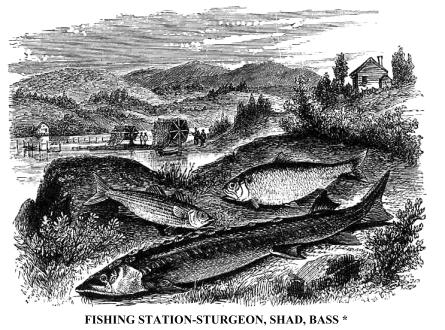 The
Sturgeon+ is also caught from the Hudson in large numbers at most of the fishing
stations. The most important of these are in the vicinity of Hyde Park, a
few miles above, and Low Point, a few miles below, the city of Poughkeepsie.
These fish are sold in such quantities in Albany, that they have been called,
in derision, "Albany beef," and the inhabitants of that ancient
town, "Sturgeonites." They vary in size from two to eight feet in
length, and in weight from 100 to 450 lbs. The "catch" commences
in April, and continues until the latter end of August. The flesh is used
for food by some, and the oil that is extracted is considered equal to the
best sperm as an illuminator. The voyagers upon the Hudson may frequently
see them leap several feet out of water when chasing their prey of smaller
fish to the surface, and they have been known to seriously injure small boats,
either by striking their bottoms with their snout in rising, or falling into
them. Bass and herring are also caught in abundance in almost every part of
the river, and numerous smaller fishes reward the angler's patience by their
beauty of form, if he be painter or poet, and their delicious flavour, if
the table gives him pleasure.
The
Sturgeon+ is also caught from the Hudson in large numbers at most of the fishing
stations. The most important of these are in the vicinity of Hyde Park, a
few miles above, and Low Point, a few miles below, the city of Poughkeepsie.
These fish are sold in such quantities in Albany, that they have been called,
in derision, "Albany beef," and the inhabitants of that ancient
town, "Sturgeonites." They vary in size from two to eight feet in
length, and in weight from 100 to 450 lbs. The "catch" commences
in April, and continues until the latter end of August. The flesh is used
for food by some, and the oil that is extracted is considered equal to the
best sperm as an illuminator. The voyagers upon the Hudson may frequently
see them leap several feet out of water when chasing their prey of smaller
fish to the surface, and they have been known to seriously injure small boats,
either by striking their bottoms with their snout in rising, or falling into
them. Bass and herring are also caught in abundance in almost every part of
the river, and numerous smaller fishes reward the angler's patience by their
beauty of form, if he be painter or poet, and their delicious flavour, if
the table gives him pleasure.
* (Refers to illustration) The largest fish in the picture is the sturgeon, the smallest the striped bass, and the other a shad. The relative sizes and proportions are correct.
+ The short-nosed Sturgeon (Acipenser brevinostris) is a large agile fish without scales, the smooth skin covered with small spinous asperities scattered equally over it. Its colour is dusky above, with faint traces of oblique bands; belly white, and the fins tinged with reddish colour.
About thirty miles below Albany, lying upon a bold, rocky promontory that juts out from the eastern shore at an elevation of fifty feet, with a beautiful bay on each side, is the city of Hudson, the capital of Columbia County, a port of entry, and one of the most delightfully situated towns on the river. It was founded in 1784 by thirty proprietors, chiefly Quakers from New England. Never in the history of the rapid growth of cities in America has there been a more remarkable example than that of Hudson. Within three years from the time when the farm on which it stands was purchased, and only a solitary storehouse stood upon the bank of the river at the foot of the bluff, one hundred and fifty dwellings, with wharves, storehouses, workshops, barns, &c., were erected, and a population of over fifteen hundred souls had settled there, and become possessed of a city charter.
The principal street of the city of Hudson extends from the
slopes of a lofty eminence called Prospect 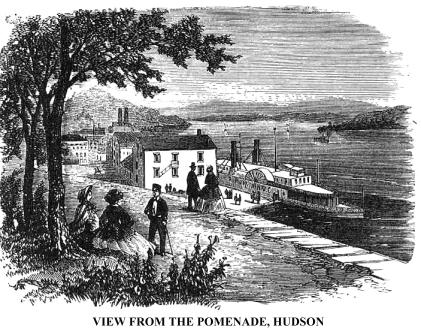 Hill,
nearly a mile, to the brow of the promontory fronting the river, where a pleasant
public promenade was laid out more than fifty years ago. It is adorned with
trees and shrubbery, and graveled walks, and affords charming views up and
down the river of the beautiful country westward, and the entire range of
the Katzbergs, lying ten or twelve miles distant. In the north-west, the Helderberg
range looms up beyond an agricultural district dotted with villages and farmhouses.
Southward the prospect is bounded by Mount Merino high and near, over the
bay, which is cultivated to its summit, and from whose crown the Highlands
in the south, the Luzerne Mountains, near Lake George, in the north, the Katzbergs
in the west, and the Green Mountains eastward, may be seen, blue and shadowy,
and bounding the horizon with a grand and mysterious line, while at the feet
of the observer, the city of Hudson lies like a picture spread upon a table.
Directly opposite the city is Athens, a thriving little village, lying upon
the river slope, and having a connection with its more stately sister by means
of a steam ferry-boat. It was first named Lunenberg, then Esperanza, and finally
was incorporated under its present title. Behind it spreads out a beautiful
country, inhabited by a population consisting chiefly of descendants of the
Dutch. All through that region, from Coxsakie to Kingston, the Dutch language
is still used in many families.
Hill,
nearly a mile, to the brow of the promontory fronting the river, where a pleasant
public promenade was laid out more than fifty years ago. It is adorned with
trees and shrubbery, and graveled walks, and affords charming views up and
down the river of the beautiful country westward, and the entire range of
the Katzbergs, lying ten or twelve miles distant. In the north-west, the Helderberg
range looms up beyond an agricultural district dotted with villages and farmhouses.
Southward the prospect is bounded by Mount Merino high and near, over the
bay, which is cultivated to its summit, and from whose crown the Highlands
in the south, the Luzerne Mountains, near Lake George, in the north, the Katzbergs
in the west, and the Green Mountains eastward, may be seen, blue and shadowy,
and bounding the horizon with a grand and mysterious line, while at the feet
of the observer, the city of Hudson lies like a picture spread upon a table.
Directly opposite the city is Athens, a thriving little village, lying upon
the river slope, and having a connection with its more stately sister by means
of a steam ferry-boat. It was first named Lunenberg, then Esperanza, and finally
was incorporated under its present title. Behind it spreads out a beautiful
country, inhabited by a population consisting chiefly of descendants of the
Dutch. All through that region, from Coxsakie to Kingston, the Dutch language
is still used in many families.
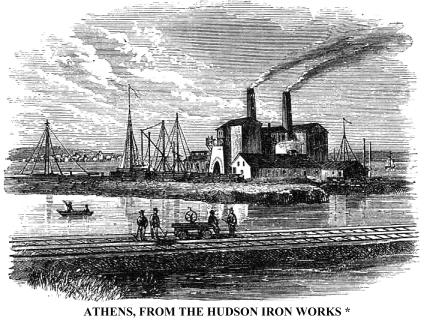 The
country around Hudson is hilly and very picturesque, every turn in the road
affording pleasant changes in landscape and agreeable surprises. A little
northward, Claverack (Het Klauver Rack, the Clover Reach) Creek comes
down from the hills in falls and cascades, and presents many romantic little
scenes. Near its banks, a few miles from Hudson, are mineral springs, now
rising into celebrity, and known as the Columbia Sulphur Springs. The accommodations
for invalids and pleasure-seekers are arranged in the midst of a fine hickory
grove, and many persons spend the summer months there very delightfully, away
from the fashionable crowd. The tourist should not omit a visit to these springs,
nor to Lebanon Springs farther in the interior. The latter may be reached
by railway and stage-coaches from Hudson, with small expenditure of time and
money.
The
country around Hudson is hilly and very picturesque, every turn in the road
affording pleasant changes in landscape and agreeable surprises. A little
northward, Claverack (Het Klauver Rack, the Clover Reach) Creek comes
down from the hills in falls and cascades, and presents many romantic little
scenes. Near its banks, a few miles from Hudson, are mineral springs, now
rising into celebrity, and known as the Columbia Sulphur Springs. The accommodations
for invalids and pleasure-seekers are arranged in the midst of a fine hickory
grove, and many persons spend the summer months there very delightfully, away
from the fashionable crowd. The tourist should not omit a visit to these springs,
nor to Lebanon Springs farther in the interior. The latter may be reached
by railway and stage-coaches from Hudson, with small expenditure of time and
money.
* The Hudson Iron Works are at the entrance of the South Bay, on a point of low land between the river and the railway. They belong to a Stock Company. The chief business is the conversion of the crude iron ore into "pigs" ready for the manufacturer's use. Two kinds of ore are used--hematite from West Stockbridge and magnetic from the Forest of Dean, Mines, in the Hudson Highlands. They produce about 16,000 tones of "pig-iron" annually.
The Lebanon Springs are the resort of many people during the
summer months, but the chief attraction 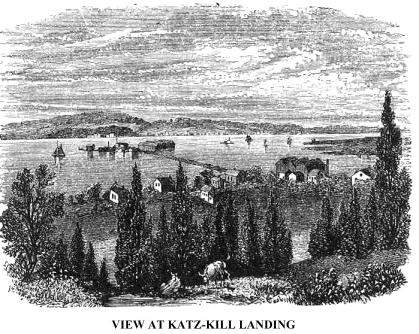 there
to the tourist is a village two miles distant, upon a mountain terrace, composed
entirely of celibates of both sexes, and of all ages, called Shakers. They
number about five hundred, and own and occupy ten thousand acres of land,
all of which susceptible of tillage is in a state of highest cultivation.
The sect or society of this singular people originated in England a little
more than one hundred years ago. Ann Lee, the young wife of a blacksmith,
who had borne several children, conceived the idea that marriage was impure
and sinful. She found disciples, and after being persecuted as a fanatic for
several years, she professed to have had a direct revelation that she was
the female manifestation of the Christ upon earth, the male manifestation
having been Jesus, the Deity being considered a duality--a being composed
of both sexes. She was, and still is, called "Mother Ann," and is
revered by her followers with a feeling akin to worship. With a few of them
she came to America, planted "the church" a few miles from Albany,
at a place called Niskayuna, and there died. There are now eighteen distinct
communities of this singular people in the United States, the aggregate membership
numbering little more than four thousand. The community at New Lebanon is
the most perfect of all in its arrangements, and there the hierarchy of the
"Millennial Church" reside. Their strange forms of worship, consisting
chiefly in singing and dancing; their quaint costume, their simple manners,
their industry and frugality, the perfection of all their industrial operations,
their chaste and exemplary lives, and the unsurpassed beauty and picturesqueness
of the country in which they are seated, render a visit to the Shakers of
Lebanon a long-to-be-remembered event in one's life.
there
to the tourist is a village two miles distant, upon a mountain terrace, composed
entirely of celibates of both sexes, and of all ages, called Shakers. They
number about five hundred, and own and occupy ten thousand acres of land,
all of which susceptible of tillage is in a state of highest cultivation.
The sect or society of this singular people originated in England a little
more than one hundred years ago. Ann Lee, the young wife of a blacksmith,
who had borne several children, conceived the idea that marriage was impure
and sinful. She found disciples, and after being persecuted as a fanatic for
several years, she professed to have had a direct revelation that she was
the female manifestation of the Christ upon earth, the male manifestation
having been Jesus, the Deity being considered a duality--a being composed
of both sexes. She was, and still is, called "Mother Ann," and is
revered by her followers with a feeling akin to worship. With a few of them
she came to America, planted "the church" a few miles from Albany,
at a place called Niskayuna, and there died. There are now eighteen distinct
communities of this singular people in the United States, the aggregate membership
numbering little more than four thousand. The community at New Lebanon is
the most perfect of all in its arrangements, and there the hierarchy of the
"Millennial Church" reside. Their strange forms of worship, consisting
chiefly in singing and dancing; their quaint costume, their simple manners,
their industry and frugality, the perfection of all their industrial operations,
their chaste and exemplary lives, and the unsurpassed beauty and picturesqueness
of the country in which they are seated, render a visit to the Shakers of
Lebanon a long-to-be-remembered event in one's life.
About six miles below Hudson is the Oak-Hill Station, opposite the Katz-Kill (Cats-Kill) landing, at the mouth of the Katz-Kill, a clear and beautiful stream that flows down from the hill country of Schoharie County for almost forty miles. It was near here that the Half Moon anchored on the 20th September, 1609, and was detained all the next day on account of the great number of natives who came on board, and had a merry time. Master Juet, one of Hudson's companions, says, in his journal,--"Our master and his mate determined to trie some of the chiefe men of the countrey, whether they had any treacherie in them. So they tooke them downe into the cabbin, and gave them so much wine and aqua vitae that they were all merrie, and one of them had his wife with him, which sate so modestly, as any of our countrey women would doe in a strange place. In the end, one of them was drunke, which had been aboord of our ship all the time that we had been there: and that was strange to them, for they could not tell how to take it. The canoes and folke went all on shoare, but some of them came againe, and brought stropes of beades [wampum, made of the clam-shell]; some had sixe, seven, eight, nine, ten, and gave him. So he slept all night quietly." The savages did not venture on board until noon the next day, when they were glad to find their old companion that was so drunk quite well again. They then brought on board tobacco, and more beads, which they gave to Hudson, "and made an Oration," and afterward sent for venison, which was brought on board.
Copyright © 1998, -- 2004. Berry Enterprises. All rights reserved. All items on the site are copyrighted. While we welcome you to use the information provided on this web site by copying it, or downloading it; this information is copyrighted and not to be reproduced for distribution, sale, or profit.